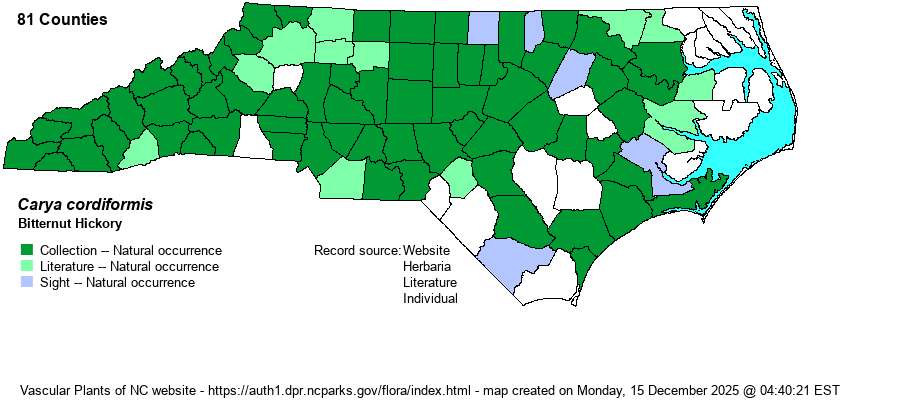| Author | (Wangenheim) K. Koch | |
| Distribution | Nearly throughout the state, but as with many trees and shrubs it is absent in far eastern counties. Apparently no records east of Bertie, Pitt, and Craven counties. Still a number of counties farther to the west have no known specimens, but should be present in all counties in the Mountains, Piedmont, and most the Coastal Plain.
An Eastern species, widespread from southern Canada to the FL Panhandle and eastern TX.
| |
| Abundance | Fairly common to common in the state, except very rare to absent in far eastern counties. Typically a common tree in some of the larger brownwater floodplains, such as the Roanoke, Neuse, Pee Dee, and Deep. Less widespread and numerous than Mockernut (C. tomentosa) and Pignut (C. glabra) hickories in the state, but more numerous than the other hickories in NC. | |
| Habitat | This is a species of very rich soil, mostly of infrequently flooded bottomland forests, natural levees, and Basic Mesic Forests. Where growing on slopes, the species is found almost always on the lower slopes, and where the soil is circumneutral. It does not normally grow in swamps, unlike the similar Water Hickory (C. aquatica). |
| Phenology | Flowers in April and May, and fruits in October. | |
| Identification | This is a familiar large deciduous tree, growing to about 90-100 feet tall, rarely to 115 feet tall. It can be easily identified by its long and narrow, naked terminal buds that are bright yellow, like no other woody species. Its alternate leaves have 7-11 leaflets, commonly 9, they being lanceolate (generally shaped like other hickories). The fruit is quite bitter tasting, hence the name. Even when the leaves are out, you should still be able to see some of the flattened yellowish buds; other hickories in the Piedmont have conical, pale brown buds that are round in cross-section. Water Hickory does have flattened scales, but they are brownish and the species has more and narrower leaflets (quite like willows). Be careful identifying Bitternut Hickory just by leaflet number, though a hickory in the Piedmont or mountains with as many as 11 leaflets is almost certainly this species. This is one of the few woody plants that might be easier to identify in winter than in summer, as the bright yellow buds are easy to spot in winter. | |
| Taxonomic Comments | None
| |
| Other Common Name(s) | Bitternut, Swamp Hickory | |
| State Rank | S4 [S5] | |
| Global Rank | G5 | |
| State Status | | |
| US Status | | |
| USACE-agcp | FAC link |
| USACE-emp | FACU link |

